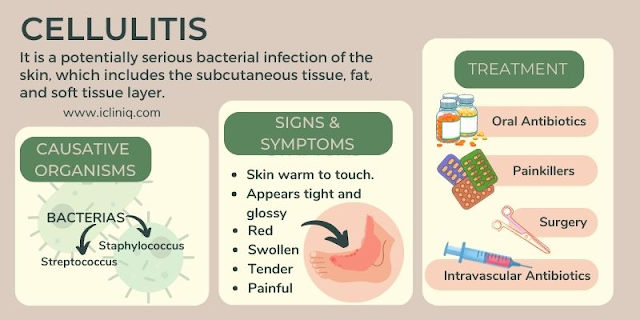Cellulitis: Symptoms, Causes, and Treatment Options
A few days ago, a young man walked into my clinic, visibly frustrated and anxious. He had developed swelling in his foot following a seemingly minor burn injury—a superficial scald from his bike’s silencer. Although the wound itself was small and not deep, the aftermath had taken a heavy toll on him, both physically and mentally.
The swelling had become a significant concern. He could no longer wear footwear, making even basic mobility a struggle. Despite consulting a local physician, his condition remained unchanged, leaving him even more distressed.
Sensing his frustration, I listened carefully and approached the case with empathy. As I gently palpated the affected area, my clinical suspicion was quickly confirmed.
(Image Showing Cellulitis)
Cellulitis:
Symptoms:
The clinical presentation of cellulitis includes a poorly demarcated, warm, erythematous area with associated edema and tenderness to palpation. On lighter skin tones, it typically appears red or pink, while on darker skin tones, it may manifest as dark brown, gray, or purple. Additional symptoms can include:
- Fluid-filled blisters
- Skin dimpling, resembling an orange peel texture
- Fever, often exceeding 100°F (38°C), chills, sweats, and fatigue are indicative of systemic involvement
- Difficulty in mobility, such as closing hands or walking, if the infection affects the hands or feet
Causes and Risk Factors:
Cellulitis is predominantly caused by beta-hemolytic streptococci, particularly group A streptococcus (Streptococcus pyogenes), followed by methicillin-sensitive Staphylococcus aureus. In immunocompromised patients, those colonized with methicillin-resistant Staphylococcus aureus (MRSA), or individuals with comorbidities such as diabetes mellitus, other bacteria may be involved. Common entry points include:
- Breaks in the skin, such as cuts, surgical sites, puncture wounds, ulcers, or insect bites
- Conditions like athlete’s foot or dermatitis that compromise skin integrity
- Risk factors include obesity, leg swelling, old age, and prior cellulitis episodes, with approximately 33% of patients experiencing recurrence, often linked to untreated skin conditions or poorly controlled diabetes (Cellulitis: Symptoms, Causes, Treatment & Recovery - Cleveland Clinic).
The infection is not typically contagious, though rare skin-to-skin contact with an infected person’s open wound may transmit it if the recipient has an open wound, highlighting the importance of hygiene.
|
Cause/Risk factor |
Details |
|
Bacteria |
Mainly Streptococcus and
Staphylococcus, including MRSA in at-risk groups
|
|
Entry Point |
Cuts, insect bites, surgical
wounds, ulcers, athlete’s foot, dermatitis
|
|
Risk Factor |
Obesity, leg swelling, old age,
diabetes, poor circulation, lymphoedema, prior cellulitis
|
|
Recurrence
Rate |
Approximately 33%, often due to
untreated skin conditions or diabetes
|
|
Contagion |
Rarely contagious, via
skin-to-skin contact with open wounds
|
|
|
|
Treatment Approaches:
Treatment strategies vary based on severity:
- Mild Cases: Oral antibiotics, such as dicloxacillin or cephalexin, are commonly prescribed, with a typical course lasting one week. Symptoms may worsen in the first 48 hours but should improve after 2-3 days, with full recovery expected in 7-10 days. It’s crucial to complete the antibiotic course even if feeling better to prevent recurrence (Cellulitis - NHS).
- Severe Cases: Hospitalization may be required, with intravenous antibiotics administered to manage rapid progression or systemic symptoms like high fever, rapid heartbeat, or confusion, necessitating emergency care (Cellulitis: Treatments, Causes, Symptoms, and More - Healthline).
- Home Care: Additional measures include applying warm compresses, elevating the affected area to reduce swelling, using compression (removing wraps or stockings twice daily for 10-15 minutes), and taking NSAIDs like ibuprofen or aspirin for pain relief after consulting a healthcare provider (Cellulitis: Symptoms, Causes, Treatment & Recovery - Cleveland Clinic).
For recurrent cellulitis, low-dose long-term antibiotics may be recommended to prevent further episodes, particularly in at-risk populations.
|
Category |
Details |
|
Mild |
Oral antibiotics (e.g., dicloxacillin,
cephalexin), 1 week, recovery in 7-10 days
|
|
Severe |
Hospitalization, IV antibiotics for rapid
progression or systemic symptoms
|
|
General
Prevention |
Clean wounds daily, apply
protective cream, cover with bandage, monitor for infection
|
|
High Risk
(Prevention) |
Inspect feet daily, moisturize, trim nails, wear
suitable footwear/gloves, treat infections promptly
|
|
Recurrent
Prevention |
Low-dose long-term antibiotics for some patients
|
|
|
|
Prevention Strategies:
Preventive measures are critical, especially for individuals with risk factors such as diabetes, poor circulation, or a weakened immune system.
- General Prevention: Wash wounds daily with soap and water, apply protective creams like Vaseline or Polysporin, cover with a bandage changed daily, and monitor for signs of infection such as irritation, pain, or pus (take extra care with skin wounds to prevent cellulitis-Cellulitis - Symptoms & Causes—Mayo Clinic).
- Specific for At-Risk Groups: For those with diabetes or poor circulation, inspect feet daily, moisturize skin regularly (avoiding open sores), trim nails carefully, wear suitable footwear and gloves, and treat surface infections like athlete’s foot promptly (Cellulitis - symptoms, treatment, and causes | healthdirect).
- Additional Tips: Keep skin clean and well-moisturized, use antiseptic cream on cuts, wear appropriate clothing and footwear, and consider gloves for outdoor work to minimize skin breaks (Cellulitis - NHS).
(Cellulitis Overview)
Complications:
Untreated cellulitis can spread to lymph nodes and the bloodstream, potentially becoming life-threatening. Signs requiring urgent medical attention include
- Very high temperature, hot and shivery feelings, fast heartbeat or breathing
- Purple skin patches (less obvious on brown or black skin), dizziness, faintness, confusion, cold, clammy, or pale skin, or unresponsiveness/loss of consciousness warrant a call to 999 or a visit to A&E, avoiding driving and requesting an ambulance (Cellulitis - NHS).
For less severe but concerning symptoms, such as an expanding, warm, tender rash without fever, seek same-day provider care or contact NHS 111 for guidance (Cellulitis - symptoms, treatment, and causes | healthdirect).


Comments
Post a Comment